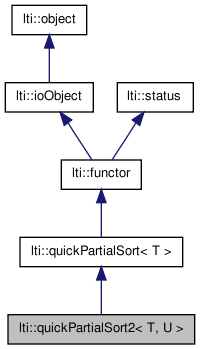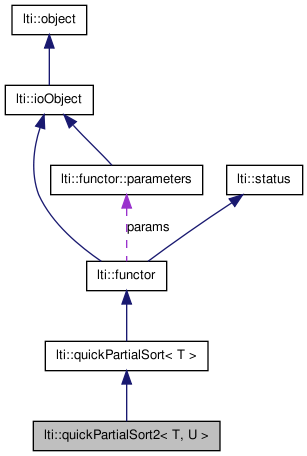

|
latest version v1.9 - last update 10 Apr 2010 |
|
Quick partial sort with colateral effects. More...
#include <ltiQuickPartialSort.h>


Public Member Functions | |
| quickPartialSort2 () | |
| quickPartialSort2 (const quickPartialSort2< T, U > &other) | |
| virtual | ~quickPartialSort2 () |
| virtual const char * | getTypeName () const |
| bool | apply (vector< T > &keys, vector< U > &data) const |
| bool | apply (std::vector< T > &keys, vector< U > &data) const |
| bool | apply (const int pivotIndex, vector< T > &keys, vector< U > &data) const |
| bool | apply (const int pivotIndex, std::vector< T > &keys, vector< U > &data) const |
| virtual functor * | clone () const |
Protected Member Functions | |
| T | findMedian (vector< T > &vct, vector< U > &data, const int &begin, const int &end, const int &medianPos) const |
| int | partition (vector< T > &vct, vector< U > &data, const int &begin, const int &end) const |
| T | findMedian (std::vector< T > &vct, vector< U > &data, const int &begin, const int &end, const int &medianPos) const |
| int | partition (std::vector< T > &vct, vector< U > &data, const int &begin, const int &end) const |
Quick partial sort with colateral effects.
This class is used to extract the n smallest elements of a vector, without requiring to complete the sort, while a second vector is sorted exactly the same way.
It is usually employed when you just required, for example, the three smallest elements of a vector.
If the so-called pivot-index is equal to vct.size()/2 (where vct is the vector you want to partially sort), then this functor is equivalent to the quickMedian.
The type of the vector elements T must accept the operator< and operator=.
Note that this functor always sorts in increasing order. If you need the n greatest elements, then just give as pivot-index vct.size()-n, and the last elements are the ones you are looking for.
| lti::quickPartialSort2< T, U >::quickPartialSort2 | ( | ) |
default constructor
| lti::quickPartialSort2< T, U >::quickPartialSort2 | ( | const quickPartialSort2< T, U > & | other | ) |
copy constructor
| other | the object to be copied |
| virtual lti::quickPartialSort2< T, U >::~quickPartialSort2 | ( | ) | [virtual] |
destructor
| bool lti::quickPartialSort2< T, U >::apply | ( | const int | pivotIndex, | |
| std::vector< T > & | keys, | |||
| vector< U > & | data | |||
| ) | const |
Partially sort the vector keys and reorder the elements of data accordingly.
Both vectors must have the same size.
| pivotIndex | pivot position on the given vector. The result has the first "pivotIndex" elements smaller or equal the rest of the vector elements. | |
| keys | vector<T> with the key data. This vector will be partially sorted. | |
| data | vector<U> with data to be sorted the same way as the keys. You can for example use a ivector initialized with the index values (i.e. data(i)=i), so that after the apply method you can check which elements are below the median and which above. |
| bool lti::quickPartialSort2< T, U >::apply | ( | const int | pivotIndex, | |
| vector< T > & | keys, | |||
| vector< U > & | data | |||
| ) | const |
Partially sort the vector keys and reorder the elements of data accordingly.
Both vectors must have the same size.
| pivotIndex | pivot position on the given vector. The result has the first "pivotIndex" elements smaller or equal the rest of the vector elements. | |
| keys | vector<T> with the key data. This vector will be partially sorted. | |
| data | vector<U> with data to be sorted the same way as the keys. You can for example use a ivector initialized with the index values (i.e. data(i)=i), so that after the apply method you can check which elements are below the median and which above. |
| bool lti::quickPartialSort2< T, U >::apply | ( | std::vector< T > & | keys, | |
| vector< U > & | data | |||
| ) | const |
Partially sort the vector keys and reorder the elements of data accordingly.
Both vectors must have the same size.
| keys | vector<T> with the key data. This vector will be partially sorted. | |
| data | vector<U> with data to be sorted the same way as the keys. You can for example use a ivector initialized with the index values (i.e. data(i)=i), so that after the apply method you can check which elements are below the median and which above. |
| bool lti::quickPartialSort2< T, U >::apply | ( | vector< T > & | keys, | |
| vector< U > & | data | |||
| ) | const |
Partially sort the vector keys and reorder the elements of data accordingly.
Both vectors must have the same size.
| keys | vector<T> with the key data. This vector will be partially sorted. | |
| data | vector<U> with data to be sorted the same way as the keys. You can for example use a ivector initialized with the index values (i.e. data(i)=i), so that after the apply method you can check which elements are below the median and which above. |
| virtual functor* lti::quickPartialSort2< T, U >::clone | ( | ) | const [virtual] |
returns a pointer to a clone of this functor.
Reimplemented from lti::quickPartialSort< T >.
| T lti::quickPartialSort2< T, U >::findMedian | ( | std::vector< T > & | vct, | |
| vector< U > & | data, | |||
| const int & | begin, | |||
| const int & | end, | |||
| const int & | medianPos | |||
| ) | const [protected] |
this method calculates the median in a recursively form
| T lti::quickPartialSort2< T, U >::findMedian | ( | vector< T > & | vct, | |
| vector< U > & | data, | |||
| const int & | begin, | |||
| const int & | end, | |||
| const int & | medianPos | |||
| ) | const [protected] |
this method calculates the median in a recursively form
| virtual const char* lti::quickPartialSort2< T, U >::getTypeName | ( | ) | const [virtual] |
returns the name of this type ("quickPartialSort2")
Reimplemented from lti::quickPartialSort< T >.
| int lti::quickPartialSort2< T, U >::partition | ( | std::vector< T > & | vct, | |
| vector< U > & | data, | |||
| const int & | begin, | |||
| const int & | end | |||
| ) | const [protected] |
this method chooses a pivot-value and ensures that lower values lie at the left and higher values at the right of its final position, which will be returned.
| int lti::quickPartialSort2< T, U >::partition | ( | vector< T > & | vct, | |
| vector< U > & | data, | |||
| const int & | begin, | |||
| const int & | end | |||
| ) | const [protected] |
this method chooses a pivot-value and ensures that lower values lie at the left and higher values at the right of its final position, which will be returned.